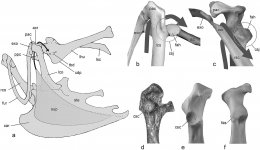Fred Ruhe
Well-known member

Gerald Mayr, 2021
The coracoscapular joint of neornithine birds--extensive homoplasy in a widely neglected articular surface of the avian pectoral girdle and its possible functional correlates.
Zoomorphology (advance online publication)
doi: https://doi.org/10.1007/s00435-021-00528-2
https://link.springer.com/article/10.1007/s00435-021-00528-2
Free pdf:
https://link.springer.com/content/pdf/10.1007/s00435-021-00528-2.pdf
Abstract
A survey is given of the morphological variation of the coracoscapular joint of neornithine birds. In Mesozoic stem group representatives, the coracoid exhibits a deeply concave cotyla scapularis, which articulates with a globose tuberculum coracoideum of the scapula. This morphology is likely to be functionally related to the development of a powerful supracoracoideus muscle and the formation of a triosseal canal as a pulley for the tendon of this muscle. In neornithine birds, the coracoid articulates with the scapula either via a concave cotyla or a flat facies articularis, with the latter largely restricting movements of the coracoid to the paramedian plane. Ancestral state reconstruction suggests that a cotyla scapularis is plesiomorphic for Neornithes and that a flat facies articularis scapularis evolved at least 13 times independently within the clade. For several lineages, the transition to a flat facies articularis scapularis can be traced in the fossil record, and the replacement of a cup-shaped cotyla by a flat articular facet seems to have been due to various functional demands. Often, a flat facies articularis scapularis is associated with reduced shafts of the furcula. A weakly developed furcula enables transverse movements of the coracoid and therefore enables a restriction of the mobility of the coracoscapular joint to the paramedian plane. In taxa with a large crop, a flat facies articularis scapularis is likely to be associated with a reorganization of the pectoral musculature, whereas in procellariiform birds, the transition from a cotyla to a facies articularis appears to have been correlated with the capacity for sustained soaring without wing flapping.
Enjoy,
Fred
The coracoscapular joint of neornithine birds--extensive homoplasy in a widely neglected articular surface of the avian pectoral girdle and its possible functional correlates.
Zoomorphology (advance online publication)
doi: https://doi.org/10.1007/s00435-021-00528-2
https://link.springer.com/article/10.1007/s00435-021-00528-2
Free pdf:
https://link.springer.com/content/pdf/10.1007/s00435-021-00528-2.pdf
Abstract
A survey is given of the morphological variation of the coracoscapular joint of neornithine birds. In Mesozoic stem group representatives, the coracoid exhibits a deeply concave cotyla scapularis, which articulates with a globose tuberculum coracoideum of the scapula. This morphology is likely to be functionally related to the development of a powerful supracoracoideus muscle and the formation of a triosseal canal as a pulley for the tendon of this muscle. In neornithine birds, the coracoid articulates with the scapula either via a concave cotyla or a flat facies articularis, with the latter largely restricting movements of the coracoid to the paramedian plane. Ancestral state reconstruction suggests that a cotyla scapularis is plesiomorphic for Neornithes and that a flat facies articularis scapularis evolved at least 13 times independently within the clade. For several lineages, the transition to a flat facies articularis scapularis can be traced in the fossil record, and the replacement of a cup-shaped cotyla by a flat articular facet seems to have been due to various functional demands. Often, a flat facies articularis scapularis is associated with reduced shafts of the furcula. A weakly developed furcula enables transverse movements of the coracoid and therefore enables a restriction of the mobility of the coracoscapular joint to the paramedian plane. In taxa with a large crop, a flat facies articularis scapularis is likely to be associated with a reorganization of the pectoral musculature, whereas in procellariiform birds, the transition from a cotyla to a facies articularis appears to have been correlated with the capacity for sustained soaring without wing flapping.
Enjoy,
Fred




